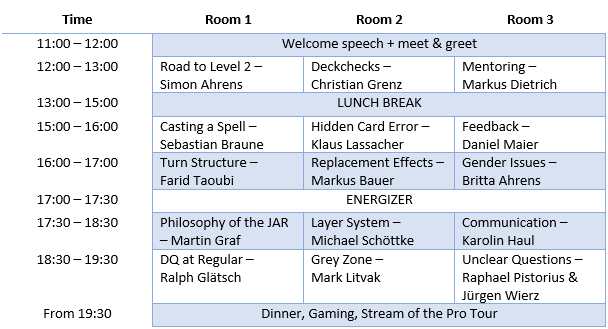
Event: 4th German speaking Judge Conference (2016)
Participants: About 90
Location: Convention Hotel, Dresden
Time: Friday (unofficial meet and greet, travel day), Saturday, Sunday
With the last german-speaking judge conference well behind us and 2017s conference slowly but steadily approaching I wanted to publish some thoughts and reflections about the organization of judge conferences. The first article in this series deals with the 2016 regional conference and contains mostly facts on how the conference went down but also some reflections about things that went as we hoped and those little bumps we did not expect on our way. As we were an organization team of three I would like to say that this report includes my personal experience although my two co-organizers have contributed their opinion to this article as well.
Day 0:
Since many judges arrived on Friday we enjoyed an evening of gaming, chatting and catching up. The hotel lobby was comfortable enough and there was food and drinks for those who wanted some.
Day 1:

The organization team met 45 Minutes before the start of the conference. I feel this could have been a bit earlier as some preparations might have profited from more time. In the end the time was sufficient to set everything up though.
By the day of the conference all short summaries of the seminars had been handed in by the presenters so we could provide a good overview on the conference topics that were hung up around the conference area together with the schedules of the two days. This was a great improvement over the previous year, when every speaker would visit each room to do a quick summary of what he would talk about in his seminar.
We had one large room for the welcoming speech, which could be divided into three smaller rooms after that. This went down smoothly as the conference hotel staff was tuned into our timetable. The first line of talks went well although it took some time to set up the computers in all rooms.
There was a certain hold up in the conference schedule because lunch took about half an hour longer than expected. I think this was unfortunate but not too problematic. Although I encouraged all presenters to take their full time, almost all of them finished a bit early so the next talk was no longer delayed. In the feedback about the conference this was mentioned by others as negative so it should probably be avoided in the future.
For evening entertainment we streamed the ProTour in Honolulu that took place at the same time as the conference which was appreciated by some. Other than that there was no special program and everybody did as they pleased which mostly meant going out for dinner or various types of gaming. We managed (though relatively late) that we could stay in our conference rooms as long as we wanted. Luckily the hotel was fine with this but at the next conference it would be useful to make sure up front.
Day 2:

The day was smooth except for the room distribution for the last talks. We had a two hour workshop in room 1, cheating investigations after scorekeeping in room 2 and two hour community building in room 3. While room two was filled Ok, room 2 was overly populated while room 1 was almost empty. We had placed all those talks next to each other with the idea that they might draw the same amount of people but obviously that wasn‘t the case. I am unsure on how to solve this problem in the future as it is hard to say which talks will draw the most crowds. As we did well in all the other cases I see no other way but to book this as „that-thing-that-happens-some-time“ and move on from it.
In the end we had a finishing talk with everybody and we made a point to thank all the presenters in a ceremonial way. In my opinion this was a great way to finish the conference and to thank everybody who was involved.
General things:
In our eyes the conference ran quite smoothly. One thing is that we planned the talks too long. We suggested a 45 minute window for talks and a 15 minute window for discussions. In many cases 30-35 minutes would have been sufficient leaving more room for discussion or setting up the next talk.
For the first time on the conference we had provided nametags which were a success in the way that at least everybody was wearing theirs. This was something I came up with at the 2015 conference. Back then I was a new judge and did not know a lot of people and I felt that the name tags helped new members to make contact with people faster or put them into context more easily. One hiccup of the nametags was, that they were done at the very last minute and the spell checking on them should have been done more carefully.
The whole IT set-up was done badly, mostly because we kind of took it for granted. Unfortunately we did not have access to all the presentations at the day of the conference and those we did have were only on one of our computers. This was a large oversight on our part because in some cases we had to run around and provide the talks to the presenter via USB which did take a lot of time. More than just one person had brought his or her own computer and in some cases the proper cables were missing which slowed down the start of some talks.
We had a good mixture of “new” and “old” speakers who did a good job concerning the quality of the talks. Of course we had the inexperienced speaker here and there or somebody who over- or underestimated his time, but all in all I feel that the speakers did very well. Also, this kind of conference is not just meant for the public to be educated but also for giving first-time speakers the possibility to grow, which in my opinion was a definite opportunity during the conference.
As we had three parallel tracks the program was diverse enough so everybody had the option to see something they had not seen yet. One challenge was to create a timetable with three talks that would divide the conference members equally as we did not want to overcrowd some talks while other speakers would stand in an empty room.
After the conference:
Feedback:
The feedback was delivered often directly to the presenters after their talks or via an online feedback form after the conference. Concerning the online form we got feedback from about 15% of the participants which is not a terrible outcome considering the presenters already got a lot of feedback right after their talk although I think the whole set-up of the feedback leaves some room for improvements.
Upload of the Seminars:
After the conference we wrote to the presenters thanking them once more for their talks. As we had not collected the talks up-front it was a bit of a hunt getting our hands on them after the conference. As talks were held in mostly PowerPoint many of the handed in slides are in PowerPoint as well, which is not ideal as the slides might look (and behave) differently depending on the version of Microsoft Office the people own.
Debriefing:
Almost as important as the feedback that comes from the participants of the conference is the feedback from the organization team to each other. We had a very constructive discussion about what went well and what to do better. This debriefing was done very close to the conference to make sure the memories were still fresh.
I hope that this article refreshed your memory on how the 2016th german-speaking judge conference went down. We plan to make a few changes in the organization and execution of this year’s conference and we are still happy about feedback you can give us on how to improve 2017th conference. The next article will give you an insight on our work concerning the organization that took place before the conference.
Artikel von Britta Ahrens
Redaktionelle Bearbeitung von Daniel Maier
